Definition, Graph, Properties, Solved Example Problems, Applications - The Cosine Function and Inverse Cosine Function | 12th Mathematics : UNIT 4 : Inverse Trigonometric Functions
Chapter: 12th Mathematics : UNIT 4 : Inverse Trigonometric Functions
The Cosine Function and Inverse Cosine Function
The Cosine Function and Inverse Cosine Function
The cosine function is a function with R as its domain and
[−1, 1] as its range. We write y = cos x and y = cos−1 x or
y = arccos(x) to represent the cosine function and
the inverse cosine function, respectively. Since cos ( x + 2π ) =
cos x is true for all real numbers x and
cos ( x + p) need not be equal to cos x for 0 < p <
2π , x ∈ R , the period
of y = cos x is 2π.
1. Graph of cosine function
The graph of cosine function is the graph of y = cos x ,
where x is a real number. Since cosine function is of period 2π
, the graph of cosine function is repeating the same pattern in each of the
intervals ….,
[−4π , − 2π ] , [ − 2π , 0] , [0, 2π ] , [2π
, 4π ] , [4π , 6π ] , …. . Therefore, it
suffices to determine the portion of the graph of cosine function for x ∈ [0, 2π ] . We construct the following table to identify
some known coordinate pairs (x, y) for points on the graph of y
= cos x , x ∈ [0, 2π ].

The table shows that the graph of y = cos x ,
0 ≤ x ≤ 2π , begins at (0,1). As x increases from 0
to π , the value of y = cos x decreases from 1 to −1 .
As x increases from π to 2 π , the value of y increases from
−1 to 1. Plot the points listed in the table and connect them with a smooth
curve. The portion of the graph is shown in Fig. 4.10.
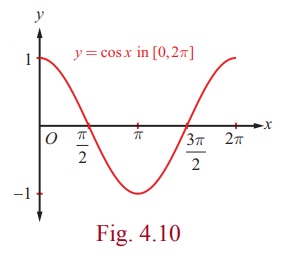
The graph of y = cos x , x ∈ R consists of
repetitions of the above portion on either side of the interval [0, 2π ]
and is shown in Fig. 4.11. From the graph of cosine function, observe that cos x
is positive in the first quadrant (for 0 ≤ x ≤ π/2), negative in the
second quadrant ( for π/2 < x ≤ π) and third quadrant ( for π < x
< ≤ 3π/2) and again it is positive in the fourth quadrant ( for 3π / 2 < x
< 2π).
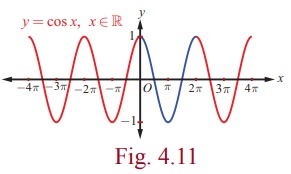
Note
We see from the graph that cos(− x ) = cos x for all x , which asserts that y = cos x is an even function
2. Properties of the cosine function
From the graph of y = cos x , we observe the
following properties of cosine function:
1.
There is no break or discontinuities in the curve. The cosine
function is continuous.
2.
The cosine function is even, since the graph is symmetric about y
-axis.
3.
The maximum value of cosine function is 1 and occurs at x =…
, − 2π , 0, 2π , … and the minimum value is − 1 and occurs at x
=… , − π , π , 3π , 5π , …. . In other words,
−1≤ cos x ≤1 for all x ∈ R .
Remark
(i) Shifting the graph of y = cos x to the right π/2
radians, gives the graph of y = cos ( x – π/2 ) , which is same
as the graph of y = sin x . Observe that cos ( x – π/2 ) = cos ( π/2 - x
) = sin x .
(ii) y = A sin α x and y = B cos β x always satisfy the
inequalities – |A| ≤ A sin α x ≤ |A| and - |B| ≤ B cos β x ≤ |B| . The
amplitude and period of y = A sin α x are |A| and 2π/|α| , respectively and
those of y = B cos β x are |B| and 2π/|β| , respectively.
The functions y = A sin α x and y = B cos β x
are known as sinusoidal functions.
(iii) Graphing of y = A sin α x and y = B cos β x are obtained by
extending the portion of the graphs on the intervals [0 , 2π/|α| ] and [0,
2π/|β| ] , respectively.
Applications
Phenomena in nature like tides and yearly temperature that cycle
repetitively through time are often modelled using sinusoids. For instance, to
model tides using a general form of sinusoidal function y = d + a cos (bt
− c) , we give the following steps:
(i) The amplitude of a sinusoidal graph (function) is one-half
of the absolute value of the difference of the maximum and minimum y -values
of the graph.
Thus, Amplitude , a = 1/2 ( max − min) ; Centre line is
y = d , where d = 1/2 ( max + min)
(ii) Period, p = 2 × ( time from maximum to minimum) ; b = 2π/p
(iii) c = b × time at which maximum occurs.
Model-1
The depth of water at the end of a dock varies with tides. The
following table shows the depth ( in metres ) of water at various time.

Let us construct a sinusoidal function of the form y = d
+ a cos (bt - c) to find the depth of water at time t.
Here, a = 1.4 ; d =
2.8 ; p = 12 ; b = π/6 ; c =
π /3.
The required sinusoidal function is y = 2.8 +1.4 cos( π/6
t – π/3 )
Note
The transformations of sine and cosine functions are useful in
numerous applications. A circular motion is always modelled using either the
sine or cosine function.
Model-2
A point rotates around a circle with centre at origin and radius
4. We can obtain the y -coordinate of the point as a function of the
angle of rotation.
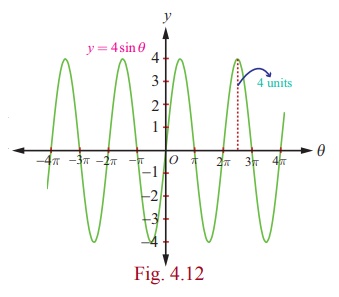
For a point on a circle with centre at the origin and radius a,
the y -coordinate of the point is y = a sinθ
, where θ is the angle of rotation. In
this case, we get
the equation y(θ ) = 4 sinθ , where θ is in radian, the
amplitude is 4 and the period is 2π . The amplitude 4 causes a
vertical stretch of the y -values of the function sin θ by
a factor of 4.
3 .The inverse cosine function and its properties
The cosine function is not one-to-one in the entire domain R
. However, the cosine function is one-to-one on the restricted domain [0, π ]
and still, on this restricted domain, the range is [−1, 1]. Now, let us define
the inverse cosine function with [−1, 1]as its domain and with [0, π ]
as its range.
Definition 4.4
For -1 ≤ x ≤ 1, define cos-1 x as the
unique number y in [0, π] such that cos y = x
. In other words, the inverse cosine function cos-1 : [-1, 1] → [0, π]
is defined by cos-1 (x) = y if and only if cos y = x and
y ∈[0, π ].
Note
(i) The sine function is non-negative on the interval [0, π ],
the range of cos−1 x . This observation is very important for some of the
trigonometric substitutions in Integral Calculus.
(ii) Whenever we talk about the inverse cosine function, we have
cos x : [0, π ] → [−1, 1] and cos−1 x : [−1, 1] → [0, π ] .
(iii) We can also restrict the domain of the cosine function to
any one of the intervals …,[−π
, 0],[π , 2π ],…., where it is one-to-one and its range is
[−1, 1].
The restricted domain [0, π ] is called the principal domain of cosine function and
the values of y = cos−1 x , −1 ≤ x ≤ 1, are known as principal values of the function y =
cos−1 x .
From the definition of y = cos−1 x , we observe
the following:
(i) y = cos-1x if and only if x = cos y for -1
≤ x ≤ 1 and 0 ≤ y ≤ π .
(ii) cos (cos-1 x) = x if |x| ≤
1 and has no sense if |x| > 1 .
(iii) cos-1 (cos x) = x if 0 ≤ x ≤ π , the
range of cos-1 x . Note that cos-1 (cos 3π ) = π .
4. Graph of the inverse cosine function
The inverse cosine function cos-1 : [-1, 1] →[0, π ], receives a real number
x in the interval [−1, 1] as an input and gives a real number y in the interval [0, π ]as an output (an
angle in radian measure). Let us
find some points (x, y)
using the equation y = cos-1 x and plot them in the xy -plane. Note that the
values of y decrease from π to 0 as x increases from -1 to 1. The
inverse cosine function is decreasing and continuous in the domain. By
connecting the points by a smooth curve, we get the graph of y = cos-1 x as shown in Fig. 4.14
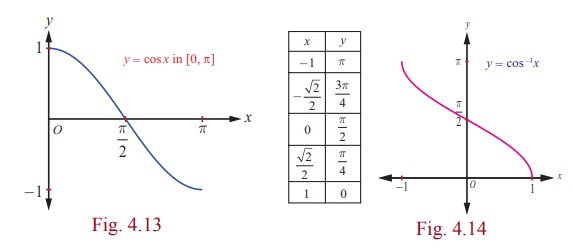
Note
(i) The graph of the function y = cos-1 x is also
obtained from the graph y = cos x by interchanging x and
y axes.
(ii) For the function y = cos-1 x , the x -intercept
is 1 and the y -intercept is π/2 .
(iii) The graph is not symmetric with respect to either origin
or y -axis. So, y = cos-1 x is neither even nor odd function.
Example 4.5
Find the principal value of cos-1 ( √3 / 2 ) .
Solution
Let cos-1 (√3 / 2 ) = y . Then, cos y = √3 / 2.
The range of the principal values of y = cos-1 x is [0, π ].
So, let us find y in [0, π ] such that cos y = √3 / 2
But, cos π/6 = √3/2
and π/6 ∈ [0,π ]. Therefore, y = π /6
Thus, the principal value of cos-1 (√3/2 ) is π/6 .
Example 4.6
Find
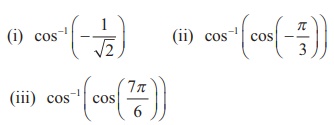
Solution
It is known that cos-1 x : [-1, 1] → [0, π ] is given
by
cos-1 x = y if and only if x = cos y for -1 ≤ x ≤ 1
and 0 ≤ y ≤ π .
Thus, we have

Example 4.7
Find the domain of cos-1 ( [2 + sin x] /3 ) .
Solution
By definition, the domain of y = cos-1 x is -1 ≤ x ≤ 1
or |x| ≤1 . This leads to
-1 ≤ [2 + sin x]/3 ≤ 1 which is same as - 3
≤ 2 + sin x ≤ 3 .
So, - 5 ≤ sin x ≤ 1 reduces to -1 ≤ sin x ≤
1, which gives
- sin-1 (1) ≤ x ≤ sin-1 (1) or π/2 ≤ x ≤ π/2 .
Thus, the domain of cos-1 ( [2 + sin x] /3 ) is [- π/2 , π/2
] .
Related Topics